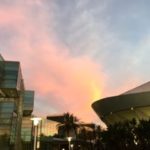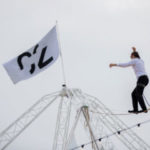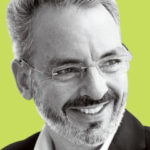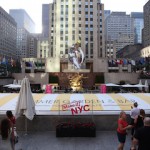There are many experiences that have stayed with me from my first-ever visit to Dubai. The view of the city’s skyline from the Burj Khalifa, for example, which, at more than 160 stories, is both the tallest man-made structure in the world and surprisingly delicate-looking. I marveled, as many visitors do, at the only-in-Dubai attractions, such as Palm Jumeirah, the world’s largest artificial island, built in the Arabian Gulf in the shape of a palm tree, fronds and all, and dotted with luxury hotels.
But among the most striking images was a 30-year-old, black-and-white photograph of the Dubai World Trade Centre (DWTC). In the picture, the 39-story tower, built along what is now known as Sheik Zayed Road, is surrounded by an expanse of almost nothing but sand.
It vividly illustrates how quickly Dubai has grown. The DWTC complex, which includes the Dubai International Convention and Exhibition Centre, is now the largest meeting facility in the Middle East, hosting more than 500 events a year, with 1 million square feet of exhibit space and more to come. And Sheik Zayed Road, still a major artery, is lined with rows of skyscraping hotels and high-rise commercial buildings, with the gleaming Dubai Metro running alongside it.
Since the 1930s, Dubai has grown from a fishing village where pearl diving was a major occupation to the fourth-most-visited destination in the world. The emirate, which has a population of 2.5 million people, attracted 13.3 million international visitors in 2014 — the same year leaders announced the goal of increasing that number to 20 million by 2020, when Dubai will host Expo 2020 Dubai, the first world expo to be held in the Middle East, Africa, or South Asia. Plans also include the construction of more hotels, including more three- and four-star properties, increasing the number of guest rooms from 98,000 to 150,000 or more by the end of 2020.
Those may seem like wildly ambitious goals. But “the truth is,” said Issam Kazim, CEO of the Dubai Corporation for Tourism and Commerce Marketing, “whatever we see Dubai set its sights on, we always manage to achieve it.”
BEHIND THE BLING
“The glitzier side — the bling side of Dubai — is already well-known,” Kazim said in an interview with Convene in his office. Along with meeting professionals from Europe and the United States, I was in the emirate to learn about the other Dubai, a business and global center with a growing reputation as a meeting destination.
On our first evening, we gathered at The Ritz-Carlton, Dubai International Financial Centre, where I immediately felt right at home. I later realized that the 14-story hotel’s retro limestone façade and exterior architectural features are reminiscent of Chicago’s historic Drake Hotel. One of Dubai’s charms is its exuberant range of architectural styles, from envelope-pushing modern designs by famous global architects to buildings that explicitly nod to landmarks in other parts of the world, like the Al Yaquob Tower hotel, which is a dead ringer for London’s Big Ben, minus the clock.
That evening, The Ritz-Carlton was humming with activity, but the hotel staff gave us a glimpse of the property’s wood-paneled ballroom, which was in the final stages of preparation for a glamorous wedding party. Masses of pink and white roses bloomed on the tables, illuminated by hundreds of white lights suspended from the ceiling. Afterward, we dined at the hotel’s Art Deco–inspired Café Belge, where our attention was divided between the fashionably dressed clientele and a delicious Belgian-style dinner, including a show-stopping chocolate dessert.
PUNCTURING STEREOTYPES
Our official orientation to Dubai came the next morning, in the form of Nasif Kayed, the energetic director of the Sheikh Mohammed bin Rashad Centre for Cultural Understanding. Established nearly 20 years ago in a traditional house in the historic Al Fahidi district to give visitors an opportunity to learn about Emirati heritage and culture, the center is a popular stop for groups and visitors from the West.
In our case, Kayed came to us, speaking in a light-filled, second-floor meeting room at the new, 54-story, 574-room Sheraton Grand Hotel, which served as our home base. The hotel sits on a traffic roundabout just steps from the DWTC but has a tranquil, oasis-like quality, awash in creamy neutrals and warm browns, with a spa and rooftop pool — along with seven meeting rooms, including a 3,875-square-foot ballroom that can hold up to 400 people.
Kayed’s presentation was anything but serene. A former businessman, he delights in puncturing stereotypes about Dubai, but also in connecting the dots in the emirate’s history. In the 19th century, Kayed noted, Dubai, with its natural harbor, was home to some of Arabia’s largest open-air markets, or souks. “And,” he said, “we still have a lot of shopping.”
Only a few days earlier, the United Arab Emirates had celebrated its 44th National Day, marking the anniversary of its creation, which joined together seven emirates, including Dubai and Abu Dhabi. Oil was discovered in Dubai in the 1960s and transformed the emirate, Kayed said, but today only represents about 5 percent of its income. The emirate’s sheiks — Dubai has been ruled by the Al Maktoum family since the 1830s — have invested oil revenues in building infrastructure, improving education, and funding initiatives that have diversified Dubai’s economy.
Emirates Airline, which was founded in the 1980s by the Dubai government, has been rapidly expanding its international routes. The airline now brings in 6,000 passengers daily from 10 gateways in the United States. In 2015, Dubai International Airport supplanted London’s Heathrow Airport as the world’s busiest for international passengers, with more than 78 million international travelers.
One of the things that sets Dubai apart is the fact that the emirate works almost like a corporation, according to Kazim. “It’s the key to our success, really,” he said. “You get the support from all the stakeholders, public and private, and they all align, and make sure they work when we need to deliver. That’s a very unique thing.”
Another unique thing: Emirati citizens are in the minority. In Dubai, 95 percent of the population are expatriates, from 200 countries around the world. “Growing up for me and going to a class, it was almost a mini United Nations,” Kazim said. “Having practically every nationality represented was normal. I honestly believe the fact that Dubai is so hospitable and so welcoming has played a key role in Dubai’s success.”
The diversity of Dubai’s population makes itself felt in many ways, including in its cuisine. Over at the DWTC, Director of Kitchens Harald Oberrender led us on a tour of the center’s cooking facilities, where he oversees 150 chefs from 19 different countries and five continents. (Oberrender displayed his own nationality by wearing a collar in the colors of the German flag.) The DWTC catering staff regularly serves up to 15,000 conference and exhibition attendees daily, and also caters Dubai’s royal weddings. After a tour of the kitchens, where clouds of steam rose over gleaming vats where food was being prepared, we ate on linen tablecloths in the employee dining room.
We also toured the DWTC’s convention center, the Dubai International Convention and Exhibition Centre, which, with residential housing and commercial businesses, is a city within a city. On the day we visited, Cisco’s Internet of Things World Forum was in full swing, preventing us from touring many of the meeting rooms. But we walked the marble floors and heard about the convention center’s expansion plans, which include adding a 4,000-seat theater.
THE VIEW FROM THE TOP
Our next stop was the Dubai Mall — which, with more than 1,200 stores, is one of the largest shopping malls in the world. We stopped a minute to watch the fish swimming in one of the mall’s attractions, the 10-million-liter Dubai Aquarium, which sits just opposite the world’s largest candy store, Candylicious.
Also inside the mall is an entrance to the Burj Khalifa’s 124th-floor observation deck. Anyone familiar with the long, snaking lines at the Empire State Building will appreciate the planning that went into the trip to the top of the Burj Khalifa. Groups of ticket-holders wait in a lounge, where they are served dates and cups of Arabian coffee, while they wait for elevators that will whisk them up to the observation deck in what seems like an impossibly short time. We made it to the top as night fell, and looked out over a city transformed, with the Arabian Gulf on one side, sand on the other, and the glittering ribbon of lights that is Dubai in between.
CLUSTERING KNOWLEDGE
Business was on the agenda the next morning, at a forum at the Dubai Chamber of Commerce & Industry. The event drew U.S. and European meeting professionals, as well leaders from local organizations, including the Dubai Association Centre, which was founded in 2014 and currently is home to 18 international associations. Dubai is fertile ground for U.S. associations that are looking to expand internationally, according to Samir Hamrouni, CEO of the World Free Zone Organization, which is headquartered in Dubai. “There is enormous energy for growth,” he said. “We are always looking to upgrade.”
Indeed, Dubai is the first city in the region to establish knowledge clusters, which are set up as free-trade zones. Leading clusters include Dubai Healthcare City; Dubai Studio City, dedicated to the growth of film and music production; and Dubai Internet City. “We’re trying to demonstrate to international associations that this knowledge is available in Dubai,” said Steen Jakobsen, director of business events for Dubai Business Events. “An association that comes into Dubai and organizes an event can tap into those connections between the international association and the local knowledge community.”
In September 2016, the Society of Petroleum Engineers (SPE) will bring its Annual Technical Conference and Exhibition to the DWTC — the first time the meeting has been held in Dubai. One of the most convincing arguments for doing so was how connected Dubai is to the rest of the world: One-third of the world’s population can fly to Dubai in four hours or less; two-thirds can make the trip in eight hours or less.
That afternoon, we took off in a caravan of white four-wheel-drive vehicles, heading into the desert for an hour of dune-bashing. It was exhilarating, but the next phase of our desert adventure was much more my speed: Our hosts literally rolled out a red carpet in the sand, where we sat on embroidered cushions and sipped Champagne as the sun slowly set. We also were treated to a presentation by falconer Pete Bergh, an Australian, who explained the centuries-old role of falcons in helping the Bedouin people hunt in the desert. Bergh offered us a chance to let the falcon perch on our (gloved) hands, but instead I took picture after picture, trying to capture the ancient sight of a bird in flight in the same frame with the airplanes that were regularly leaving Dubai International Airport.
Dinner that night was meat roasted over charcoal fires, which we ate in a rustic yet luxurious desert camp, outfitted with rugs and cushions, and lit by lanterns. We took turns riding on a camel, and ended the evening watching performances of traditional dances, including the whirling tanoura, a folk dance performed by Egyptian Sufi.
When people think of Dubai, they usually think back 44 years, to the creation of the UAE, Kazim said. “But there is history to Dubai as well,” he said. “There’s a certain unique culture that exists, and it’s something that we’re continuously working on developing — to make sure that we highlight those traditional areas and districts in Dubai, and bring that to the forefront.”
I experienced that for myself one afternoon, when I spent an hour wandering the textile, spice, and gold souks in the historic district. The highlight was a short ride along Dubai Creek, in one of the many gasoline-powered abras that take passengers from one souk to another in a swirl of color and sound. The lifestyle around Dubai Creek, where Dubai began, was the inspiration for Madinat Jumeirah, a sprawling, sand-colored hotel, dining, and conference facility built in the style of old Arabia. The conference center offers the largest event portfolio in Dubai outside of the DWTC, including a 1,000-seat amphitheater and nearly 10,000 square feet of meeting space, plus an outdoor terrace.
The property includes a private beach, hotels, traditional summer houses, and villas, along with more than 40 restaurants and bars. Guests navigate Madinat Jumeirah’s three kilometers of waterways in wooden abras, and can shop at the sprawling Madinat souk or stroll down palm-lined walkways. Our farewell dinner took place on a terrace overlooking the water, where we were seated at a long wooden table — a final reminder of the warmth of Arabian hospitality.






